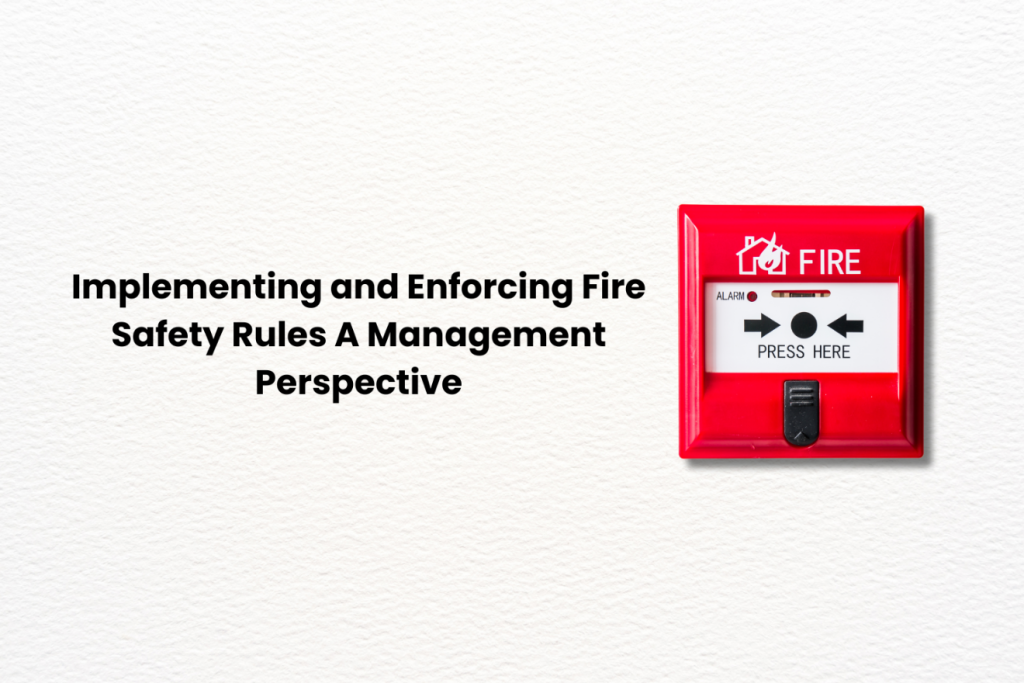Implementing and enforcing Fire Safety Rules is a critical aspect of a comprehensive safety strategy. In this blog, we will explore the management perspective on fire safety, emphasizing the role of proactive measures, adherence to regulations, and the importance of ongoing education, including participation in a Fire Safety Course.
Table of contents
- The Significance of Fire Safety Rules
- Crafting Effective Fire Safety Rules
- Enforcing Fire Safety Rules: Management’s Role
- Ongoing Commitment to Fire Safety
- Conclusion
The Significance of Fire Safety Rules
Preventing Incidents: Preventing fires is the primary goal of fire safety regulations. Management lessens the possibility of fire dangers in the organisation by creating and disseminating clear regulations and standards. When safeguarding people and their possessions, prevention is always better than cure.
Ensuring Compliance: Adherence to fire safety rules is often a regulatory requirement. This goes beyond just being the law; it shows how seriously the company takes the welfare of its employees. Two benefits of following fire safety rules are avoiding legal repercussions and encouraging a culture of accountability.
Mitigating Risks: Fire safety rules are designed to identify and mitigate risks. These regulations cover the use of electrical equipment, the storage of combustible goods, and emergency response protocols. Management’s systematic approach to addressing possible hazards may reduce the chance of fire events and their repercussions.
Crafting Effective Fire Safety Rules
Understanding the Environment: Comprehending the organization’s surroundings is the first step in crafting appropriate fire safety regulations. Think about the processes, the equipment, and the unique fire hazards of the sector. Improving the rules’ relevance and influence may be achieved by adapting them to the specific features of the environment.
Involving Stakeholders: Effective fire safety rules should involve input from various stakeholders, including employees, safety officers, and relevant experts. Including many viewpoints helps management ensure the rules are thorough, workable, and approved by the people who must follow them.
Clarity and Accessibility: Fire safety rules must be communicated and easily accessible to all occupants. To make your point, use simple language, visual aids, and signs. Keep the regulations up-to-date by reviewing them regularly and making sure everyone in the company knows about them.
Enforcing Fire Safety Rules: Management’s Role
Lead by Example: Leadership is the first step in ensuring fire safety standards are effectively enforced. Those in charge should set a good example by actively pursuing and enforcing fire safety protocols. Workers are more inclined to prioritise fire safety and follow the regulations when they see that management does the same.
Training and Education: Management plays a pivotal role in facilitating training and education on fire safety. Have them enrol in fire safety training to better prepare your staff for fires. Putting money into people’s education helps make the workplace safer and ensures people have the tools to deal with situations.
Regular Inspections and Audits: Implementing a schedule of regular inspections and audits is crucial for enforcing fire safety rules. Management should perform or monitor these evaluations to ensure that fire safety procedures are in place, that equipment is well-maintained, and that any dangers are immediately handled. Regular inspections foster accountability.
Prompt Action on Non-Compliance: Management must take prompt and appropriate action in instances of non-compliance with fire safety rules. Actions such as disciplinary measures, further training, or remedial measures may be necessary. Enforcing compliance with fire safety requirements consistently conveys that doing so is crucial.
Ongoing Commitment to Fire Safety
Periodic Reviews and Updates: Fire safety rules should not be static. To keep regulations up-to-date and effective, management should review and update them periodically. Organisational fire safety measures may need to be adjusted in response to operations, occupancy, or infrastructure changes.
Investing in Technology: Embrace technological solutions that enhance fire safety. Automated alarms, state-of-the-art fire detection systems, and communication platforms that allow for quick reactions in times of crisis may be part of this. Putting money into technology shows you want to be the best at fire safety.
Promoting a Culture of Safety: Management plays a crucial role in cultivating a safety culture within the organization. Not only must regulations be enforced, but a mentality shift towards making safety a priority in everything that people do must also be fostered. Building a healthy safety culture involves recognising and rewarding safe practices.
Conclusion
Implementing and enforcing fire safety regulations are crucial components of successful safety management, fostering a culture that prioritizes preventing mishaps. An organization’s commitment to environmental awareness, clear and relevant rulemaking, and rigorous compliance enforcement shapes its overall culture. Fire safety transcends mere legal obligations; it becomes a shared responsibility and a way of life within the organization when leadership sets an example, invests in Health & Safety Courses, conducts regular inspections, and remains dedicated to continuous improvements. Staff members undergoing such training contribute to a safer and risk-free workplace by enhancing their knowledge and skills.





More Stories
Divorce Without Splitting Assets: What You Need to Know
Best Alternative streaming Thoptv App for pc
Flowers Bouquet for Birthday of Your Loved Ones